

Compact Muon Solenoid
LHC, CERN
| CMS-PAS-SMP-19-010 | ||
| Measurement of the differential Z+jets and $\gamma$+jets cross sections, their ratio, and collinear Z boson emission in pp collisions at $\sqrt{s}=$ 13 TeV | ||
| CMS Collaboration | ||
| May 2020 | ||
| Abstract: Measurements of the differential cross sections of Z+jets, $\gamma$+jets, and their ratio, are presented as a function of the boson transverse momentum. Measurements are also presented of the Z boson angular distribution in events where the Z boson is emitted collinear to a jet with very high transverse momentum. The analysis is based on a data sample of proton-proton collisions at a center-of-mass energy of 13 TeV corresponding to an integrated luminosity of 35.9 fb$^{-1}$ recorded by the CMS experiment at the LHC. The data are compared to different theoretical predictions after correcting for detector effects and show varying levels of agreement. In general, the predictions at higher orders in perturbation theory show better agreement with the data. | ||
|
Links:
CDS record (PDF) ;
CADI line (restricted) ;
These preliminary results are superseded in this paper, JHEP 05 (2021) 285. The superseded preliminary plots can be found here. |
||
| Figures | |
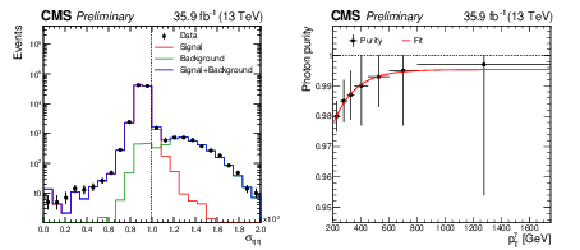
png pdf |
Figure 1:
A fit to the ${\sigma _{\eta \eta}}$ distribution using signal and background templates to extract a value for the purity in the photon ${p_{\mathrm {T}}}$ bin of 300 - 350 GeV (left). The purity value as a function of photon ${p_{\mathrm {T}}}$ as extracted from a fit to the ${\sigma _{\eta \eta}}$ distribution in each ${p_{\mathrm {T}}}$ bin. The error bars show the total statistical and systematic uncertainty (right). |

png pdf |
Figure 1-a:
A fit to the ${\sigma _{\eta \eta}}$ distribution using signal and background templates to extract a value for the purity in the photon ${p_{\mathrm {T}}}$ bin of 300 - 350 GeV (left). The purity value as a function of photon ${p_{\mathrm {T}}}$ as extracted from a fit to the ${\sigma _{\eta \eta}}$ distribution in each ${p_{\mathrm {T}}}$ bin. The error bars show the total statistical and systematic uncertainty (right). |
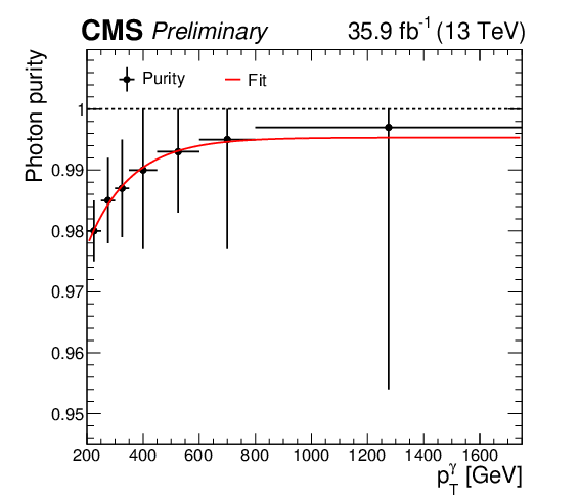
png pdf |
Figure 1-b:
A fit to the ${\sigma _{\eta \eta}}$ distribution using signal and background templates to extract a value for the purity in the photon ${p_{\mathrm {T}}}$ bin of 300 - 350 GeV (left). The purity value as a function of photon ${p_{\mathrm {T}}}$ as extracted from a fit to the ${\sigma _{\eta \eta}}$ distribution in each ${p_{\mathrm {T}}}$ bin. The error bars show the total statistical and systematic uncertainty (right). |
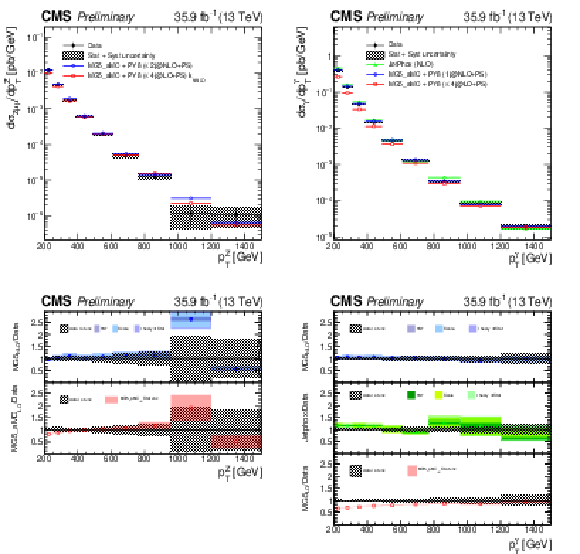
png pdf |
Figure 2:
Measured differential cross sections as a function of the boson ${p_{\mathrm {T}}}$ for Z+jets (left) and $\gamma$+jets (right) and their comparisons with several theoretical predictions. The error bars in the upper panels represent the statistical uncertainty on the measurement and the hatched band in the lower and upper panels is the sum in quadrature of the statistical and systematic uncertainty on the measurement. The lower panels show the ratio of the theory predictions to the unfolded data. The shaded error band on the LO MadGraph 5_aMC@NLO calculation is the statistical uncertainty. The dark (light) shaded error band on the NLO prediction from MadGraph 5_aMC@NLO and the JetPhox prediction represents the PDF (scale) uncertainties. |

png pdf |
Figure 2-a:
Measured differential cross sections as a function of the boson ${p_{\mathrm {T}}}$ for Z+jets (left) and $\gamma$+jets (right) and their comparisons with several theoretical predictions. The error bars in the upper panels represent the statistical uncertainty on the measurement and the hatched band in the lower and upper panels is the sum in quadrature of the statistical and systematic uncertainty on the measurement. The lower panels show the ratio of the theory predictions to the unfolded data. The shaded error band on the LO MadGraph 5_aMC@NLO calculation is the statistical uncertainty. The dark (light) shaded error band on the NLO prediction from MadGraph 5_aMC@NLO and the JetPhox prediction represents the PDF (scale) uncertainties. |
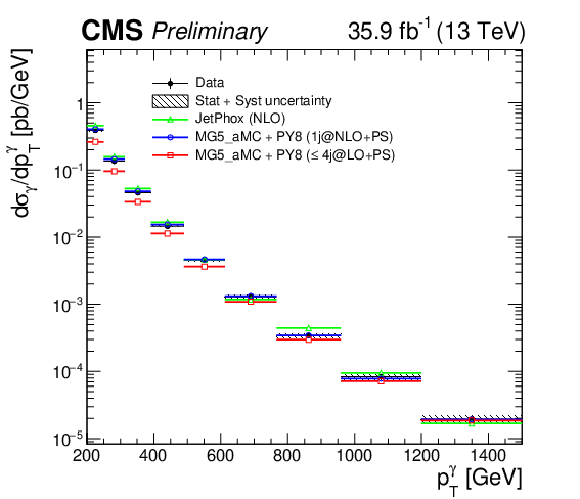
png pdf |
Figure 2-b:
Measured differential cross sections as a function of the boson ${p_{\mathrm {T}}}$ for Z+jets (left) and $\gamma$+jets (right) and their comparisons with several theoretical predictions. The error bars in the upper panels represent the statistical uncertainty on the measurement and the hatched band in the lower and upper panels is the sum in quadrature of the statistical and systematic uncertainty on the measurement. The lower panels show the ratio of the theory predictions to the unfolded data. The shaded error band on the LO MadGraph 5_aMC@NLO calculation is the statistical uncertainty. The dark (light) shaded error band on the NLO prediction from MadGraph 5_aMC@NLO and the JetPhox prediction represents the PDF (scale) uncertainties. |
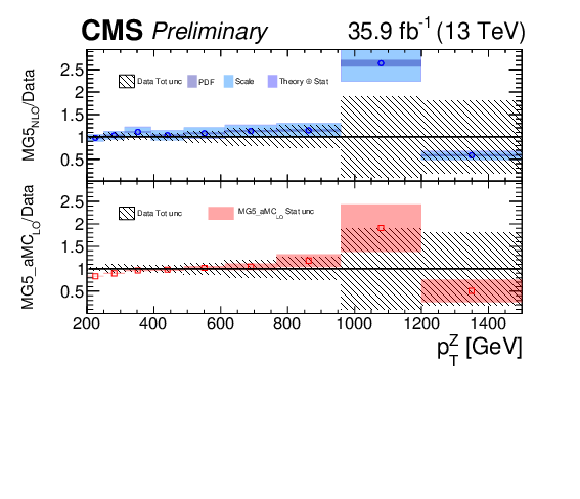
png pdf |
Figure 2-c:
Measured differential cross sections as a function of the boson ${p_{\mathrm {T}}}$ for Z+jets (left) and $\gamma$+jets (right) and their comparisons with several theoretical predictions. The error bars in the upper panels represent the statistical uncertainty on the measurement and the hatched band in the lower and upper panels is the sum in quadrature of the statistical and systematic uncertainty on the measurement. The lower panels show the ratio of the theory predictions to the unfolded data. The shaded error band on the LO MadGraph 5_aMC@NLO calculation is the statistical uncertainty. The dark (light) shaded error band on the NLO prediction from MadGraph 5_aMC@NLO and the JetPhox prediction represents the PDF (scale) uncertainties. |

png pdf |
Figure 2-d:
Measured differential cross sections as a function of the boson ${p_{\mathrm {T}}}$ for Z+jets (left) and $\gamma$+jets (right) and their comparisons with several theoretical predictions. The error bars in the upper panels represent the statistical uncertainty on the measurement and the hatched band in the lower and upper panels is the sum in quadrature of the statistical and systematic uncertainty on the measurement. The lower panels show the ratio of the theory predictions to the unfolded data. The shaded error band on the LO MadGraph 5_aMC@NLO calculation is the statistical uncertainty. The dark (light) shaded error band on the NLO prediction from MadGraph 5_aMC@NLO and the JetPhox prediction represents the PDF (scale) uncertainties. |
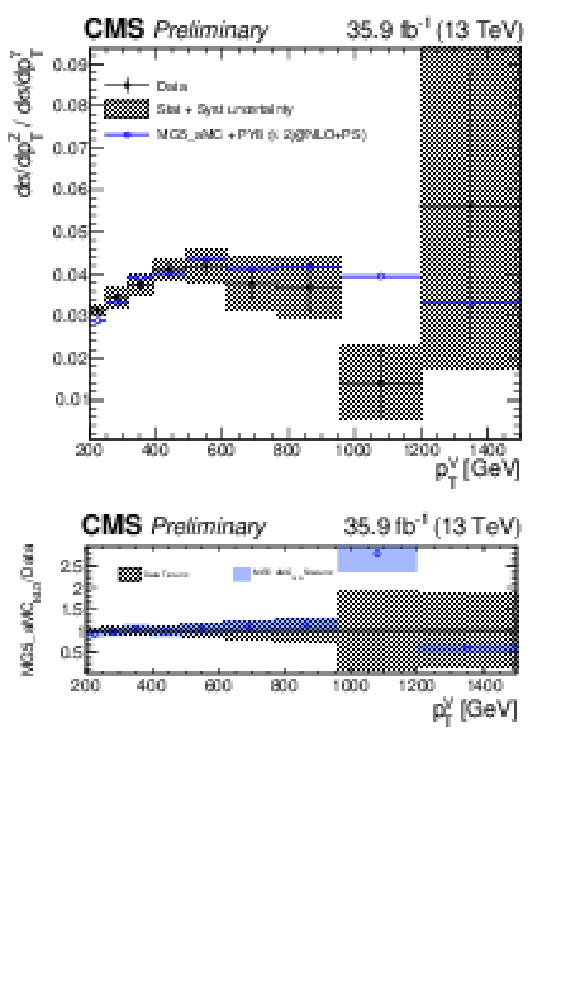
png pdf |
Figure 3:
Differential cross section ratio of Z+jets over $\gamma$+jets as a function of the vector boson transverse momentum compared to the theoretical prediction from MadGraph 5_aMC@NLO. Only vector bosons produced centrally, with $|y| < $ 1.4, in association with one or more jets, are considered. The error bars in the upper panel represent the statistical uncertainty on the measurement and the hatched band in the lower and upper panels is the sum in quadrature of the statistical and systematic uncertainty on the measurement. The lower panels show the ratio of the theory prediction to the unfolded data. The dark (light) shaded error band on the NLO prediction from MadGraph 5_aMC@NLO represents the PDF (scale) uncertainties, which are treated as uncorrelated between Z+jets and $\gamma$+jets. |
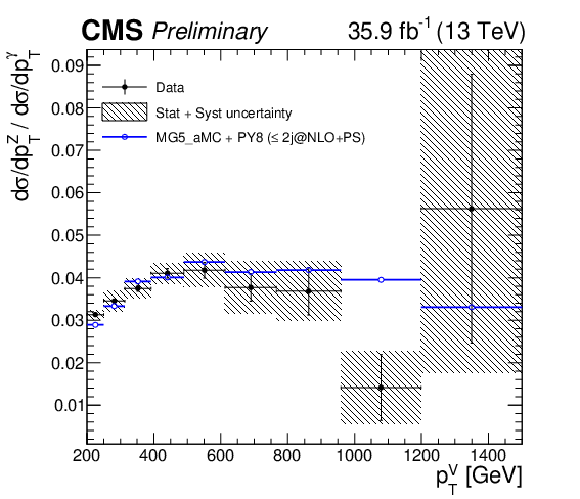
png pdf |
Figure 3-a:
Differential cross section ratio of Z+jets over $\gamma$+jets as a function of the vector boson transverse momentum compared to the theoretical prediction from MadGraph 5_aMC@NLO. Only vector bosons produced centrally, with $|y| < $ 1.4, in association with one or more jets, are considered. The error bars in the upper panel represent the statistical uncertainty on the measurement and the hatched band in the lower and upper panels is the sum in quadrature of the statistical and systematic uncertainty on the measurement. The lower panels show the ratio of the theory prediction to the unfolded data. The dark (light) shaded error band on the NLO prediction from MadGraph 5_aMC@NLO represents the PDF (scale) uncertainties, which are treated as uncorrelated between Z+jets and $\gamma$+jets. |
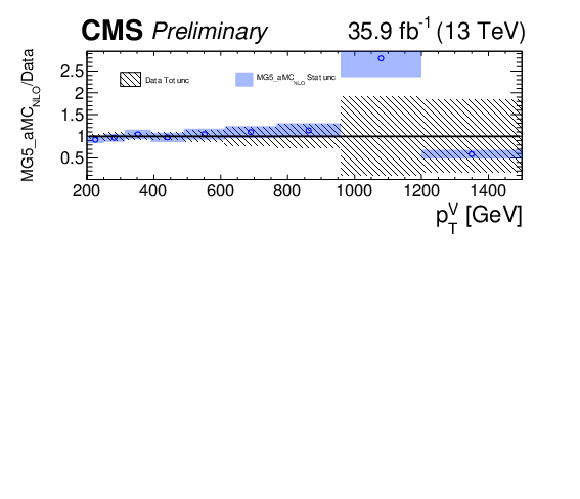
png pdf |
Figure 3-b:
Differential cross section ratio of Z+jets over $\gamma$+jets as a function of the vector boson transverse momentum compared to the theoretical prediction from MadGraph 5_aMC@NLO. Only vector bosons produced centrally, with $|y| < $ 1.4, in association with one or more jets, are considered. The error bars in the upper panel represent the statistical uncertainty on the measurement and the hatched band in the lower and upper panels is the sum in quadrature of the statistical and systematic uncertainty on the measurement. The lower panels show the ratio of the theory prediction to the unfolded data. The dark (light) shaded error band on the NLO prediction from MadGraph 5_aMC@NLO represents the PDF (scale) uncertainties, which are treated as uncorrelated between Z+jets and $\gamma$+jets. |

png pdf |
Figure 4:
Measured differential cross section of Z+jets as a function of the angular separation between the Z boson and the closest jet and the comparison with theory predictions from MadGraph 5_aMC@NLO where the leading jet ${p_{\mathrm {T}}}$ is $ > $ 300 GeV (left) and 500 GeV (right). The error bars in the upper panel represent the statistical uncertainty on the measurement and the hatched band in the lower and upper panels is the sum in quadrature of the statistical and systematic uncertainty on the measurement. The lower panel shows the ratio of the theory predictions to the unfolded data. The dark (light) shaded error band on the NLO prediction from MadGraph 5_aMC@NLO represents the PDF (scale) uncertainties. |

png pdf |
Figure 4-a:
Measured differential cross section of Z+jets as a function of the angular separation between the Z boson and the closest jet and the comparison with theory predictions from MadGraph 5_aMC@NLO where the leading jet ${p_{\mathrm {T}}}$ is $ > $ 300 GeV (left) and 500 GeV (right). The error bars in the upper panel represent the statistical uncertainty on the measurement and the hatched band in the lower and upper panels is the sum in quadrature of the statistical and systematic uncertainty on the measurement. The lower panel shows the ratio of the theory predictions to the unfolded data. The dark (light) shaded error band on the NLO prediction from MadGraph 5_aMC@NLO represents the PDF (scale) uncertainties. |

png pdf |
Figure 4-b:
Measured differential cross section of Z+jets as a function of the angular separation between the Z boson and the closest jet and the comparison with theory predictions from MadGraph 5_aMC@NLO where the leading jet ${p_{\mathrm {T}}}$ is $ > $ 300 GeV (left) and 500 GeV (right). The error bars in the upper panel represent the statistical uncertainty on the measurement and the hatched band in the lower and upper panels is the sum in quadrature of the statistical and systematic uncertainty on the measurement. The lower panel shows the ratio of the theory predictions to the unfolded data. The dark (light) shaded error band on the NLO prediction from MadGraph 5_aMC@NLO represents the PDF (scale) uncertainties. |

png pdf |
Figure 4-c:
Measured differential cross section of Z+jets as a function of the angular separation between the Z boson and the closest jet and the comparison with theory predictions from MadGraph 5_aMC@NLO where the leading jet ${p_{\mathrm {T}}}$ is $ > $ 300 GeV (left) and 500 GeV (right). The error bars in the upper panel represent the statistical uncertainty on the measurement and the hatched band in the lower and upper panels is the sum in quadrature of the statistical and systematic uncertainty on the measurement. The lower panel shows the ratio of the theory predictions to the unfolded data. The dark (light) shaded error band on the NLO prediction from MadGraph 5_aMC@NLO represents the PDF (scale) uncertainties. |

png pdf |
Figure 4-d:
Measured differential cross section of Z+jets as a function of the angular separation between the Z boson and the closest jet and the comparison with theory predictions from MadGraph 5_aMC@NLO where the leading jet ${p_{\mathrm {T}}}$ is $ > $ 300 GeV (left) and 500 GeV (right). The error bars in the upper panel represent the statistical uncertainty on the measurement and the hatched band in the lower and upper panels is the sum in quadrature of the statistical and systematic uncertainty on the measurement. The lower panel shows the ratio of the theory predictions to the unfolded data. The dark (light) shaded error band on the NLO prediction from MadGraph 5_aMC@NLO represents the PDF (scale) uncertainties. |
| Tables | |

png pdf |
Table 1:
The contributions to the uncertainty on the differential cross section measurements for the Z+jets, $\gamma$+jets, the Z$/\gamma $ ratio and collinear Z boson regions. The uncertainties are expressed in percent and a range represents the mininimum and maximum effect observed. |
| Summary |
|
The results reported in this note extend the measurements of standard model processes to probe extreme regions of phase space characterized by the production of Z+jets and ${\gamma}$+jets at large boson ${p_{\mathrm{T}}}$ and the boosted production of a ${\text{Z}} $ boson in association with at least one very high ${p_{\mathrm{T}}}$ jet. The measurements utilize data recorded by the CMS detector from pp collisions at $\sqrt{s} =$ 13 TeV at the LHC, corresponding to an integrated luminosity of 35.9 fb$^{-1}$. Comparisons are made between the unfolded data distributions and a variety of predictions from theoretical calculations. The differential measurement of the Z+jets cross section versus boson ${p_{\mathrm{T}}}$ is presented for ${p_{\mathrm{T}}}$ above 200 GeV and compared to the LO and NLO theoretical predictions from MadGraph. A similar measurement of the ${\gamma}$+jets cross section is performed and compared to theoretical predictions from MadGraph and JetPhox . The differential cross section ratio of Z+jets and ${\gamma}$+jets as a function of boson ${p_{\mathrm{T}}}$ is the first measurement of this quantity at 13 TeV at the LHC. The ratio is compared to the NLO calculation from MadGraph and probes boson ${p_{\mathrm{T}}}$ values beyond a TeV. The data is in agreement with the theoretical prediction within uncertainties for the full boson ${p_{\mathrm{T}}}$ range. The measurement of the collinear emission of a Z boson represents the first explicit study of this topology at the LHC. It is accessed by requiring the production of a Z boson in association with at least one very high ${p_{\mathrm{T}}}$ jet (above 300 GeV and 500 GeV) and measuring the differential cross section as a function of the angular separation between the Z boson and the closest jet. The region ${\Delta \text{R}_{Z,\text{closest jet}}} > $ 2.5 is dominated by the back-to-back production of a Z boson and jets while ${\Delta \text{R}_{Z,\text{closest jet}}} < $ 2.5 is enhanced in the collinear production. The unfolded data is compared with the LO and NLO calculations from MadGraph. The NLO MadGraph prediction shows agreement within uncertainties for the bulk of the distribution but underpredicts it for the low ${\Delta \text{R}_{Z,\text{closest jet}}} $ region below 0.8, which is dominated by events with the real emission of a Z boson in close proximity to a jet. Measurements such as the ones presented in this note will become increasingly important in current and future runs of the LHC, where the high center-of-mass energy and larger integrated luminosity will push the LHC physics programme into new territories, necessitating an understanding of standard model processes in regions of previously unexplored parameter space. |
| References | ||||
| 1 | W. J. Stirling and E. Vryonidou | Electroweak corrections and Bloch-Nordsieck violations in 2-to-2 processes at the LHC | JHEP 04 (2013) 155 | 1212.6537 |
| 2 | A. Denner, S. Dittmaier, T. Kasprzik, and A. M$\ddot\rm u$ck | Electroweak corrections to W + jet hadroproduction including leptonic W-boson decays | JHEP 08 (2009) 075 | 0906.1656 |
| 3 | A. Denner, S. Dittmaier, T. Kasprzik, and A. M$\ddot\rm u$ck | Electroweak corrections to dilepton + jet production at hadron colliders | JHEP 06 (2011) 069 | 1103.0914 |
| 4 | A. Denner, S. Dittmaier, T. Kasprzik, and A. M$\ddot\rm u$ck | Electroweak corrections to monojet production at the LHC | EPJC 73 (2013) 2297 | 1211.5078 |
| 5 | A. Denner, L. Hofer, A. Scharf, and S. Uccirati | Electroweak corrections to lepton pair production in association with two hard jets at the LHC | JHEP 01 (2015) 094 | 1411.0916 |
| 6 | S. Kallweit et al. | NLO QCD+EW predictions for V+jets including off-shell vector-boson decays and multijet merging | JHEP 04 (2016) 021 | 1511.08692 |
| 7 | J. Lindert et al. | Precise predictions for V+jets dark matter backgrounds | EPJC 77 (2017) 829 | 1705.04664 |
| 8 | M. Sch$\ddot\rm o$nherr et al. | NLO QCD+EW for V+jets | in Proceedings, 4th Large Hadron Collider Physics Conference (LHCP 2016): Lund, Sweden, June 13-18, 2016, volume LHCP2016, p. 58 2016 PoS | 1609.01445 |
| 9 | R. Frederix et al. | The automation of next-to-leading order electroweak calculations | JHEP 07 (2018) 185 | 1804.10017 |
| 10 | CMS Collaboration | Comparison of the Z/$ \gamma^{*} $ + jets to $ \gamma $ + jets cross sections in pp collisions at $ \sqrt{s}= $ 8 TeV | JHEP 10 (2015) 128 | CMS-SMP-14-005 1505.06520 |
| 11 | U. Baur | Weak boson emission in hadron collider processes | PRD 75 (2007) 013005 | hep-ph/0611241 |
| 12 | J. R. Christiansen and T. Sj$\ddot\rm o$strand | Weak gauge boson radiation in parton showers | JHEP 04 (2014) 115 | 1401.5238 |
| 13 | F. Krauss, P. Petrov, M. Sch$\ddot\rm o$nherr, and M. Spannowsky | Measuring collinear W emissions inside jets | PRD 89 (2014) 114006 | 1403.4788 |
| 14 | ATLAS Collaboration | Measurement of W boson angular distributions in events with high transverse momentum jets at $ \sqrt{s}= $ 8 TeV using the ATLAS detector | PLB 765 (2017) 132 | 1609.07045 |
| 15 | CMS Collaboration | Measurement of the differential cross sections for the associated production of a W boson and jets in proton-proton collisions at $ \sqrt{s}= $ 13 TeV | PRD 96 (2017) 072005 | CMS-SMP-16-005 1707.05979 |
| 16 | CMS Collaboration | The CMS trigger system | JINST 12 (2017) P01020 | CMS-TRG-12-001 1609.02366 |
| 17 | CMS Collaboration | The CMS experiment at the CERN LHC | JINST 3 (2008) S08004 | CMS-00-001 |
| 18 | J. Alwall et al. | The automated computation of tree-level and next-to-leading order differential cross sections, and their matching to parton shower simulations | JHEP 07 (2014) 079 | 1405.0301 |
| 19 | T. Sj$\ddot\rm o$strand et al. | An introduction to PYTHIA 8.2 | CPC 191 (2015) 159 | 1410.3012 |
| 20 | R. Frederix and S. Frixione | Merging meets matching in MC@NLO | JHEP 12 (2012) 061 | 1209.6215 |
| 21 | K. Melnikov and F. Petriello | Electroweak gauge boson production at hadron colliders through O($ \alpha(s)^{2} $) | PRD 74 (2006) 114017 | hep-ph/0609070 |
| 22 | J. Alwall et al. | Comparative study of various algorithms for the merging of parton showers and matrix elements in hadronic collisions | EPJC 53 (2008) 473 | 0706.2569 |
| 23 | T. Gleisberg et al. | Event generation with SHERPA 1.1 | JHEP 02 (2009) 007 | 0811.4622 |
| 24 | S. Catani, M. Fontannaz, J. P. Guillet, and E. Pilon | Cross-section of isolated prompt photons in hadron hadron collisions | JHEP 05 (2002) 028 | hep-ph/0204023 |
| 25 | P. Aurenche et al. | A new critical study of photon production in hadronic collisions | PRD 73 (2006) 094007 | hep-ph/0602133 |
| 26 | Z. Belghobsi et al. | Photon-jet correlations and constraints on fragmentation functions | PRD 79 (2009) 114024 | 0903.4834 |
| 27 | L. Bourhis, M. Fontannaz, and J. P. Guillet | Quarks and gluon fragmentation functions into photons | EPJC 2 (1998) 529 | hep-ph/9704447 |
| 28 | N. Kidonakis | Differential and total cross sections for top pair and single top production | in 20th International Workshop on Deep-Inelastic Scattering and Related Subjects, p. 831 2012 | 1205.3453 |
| 29 | M. Czakon, P. Fiedler, and A. Mitov | Total top-quark pair-production cross section at hadron colliders through O($ \alpha\frac{4}{S} $) | PRL 110 (2013) 252004 | 1303.6254 |
| 30 | P. Nason | A new method for combining NLO QCD with shower Monte Carlo algorithms | JHEP 11 (2004) 040 | hep-ph/0409146 |
| 31 | S. Frixione, P. Nason, and C. Oleari | Matching NLO QCD computations with parton shower simulations: the POWHEG method | JHEP 11 (2007) 070 | 0709.2092 |
| 32 | S. Alioli, P. Nason, C. Oleari, and E. Re | A general framework for implementing NLO calculations in shower Monte Carlo programs: the POWHEG BOX | JHEP 06 (2010) 043 | 1002.2581 |
| 33 | E. Re | Single-top Wt-channel production matched with parton showers using the POWHEG method | EPJC 71 (2011) 1547 | 1009.2450 |
| 34 | NNPDF Collaboration | Parton distributions for the LHC Run 2 | JHEP 04 (2015) 040 | 1410.8849 |
| 35 | CMS Collaboration | Event generator tunes obtained from underlying event and multiparton scattering measurements | EPJC 76 (2016) 155 | CMS-GEN-14-001 1512.00815 |
| 36 | GEANT4 Collaboration | GEANT4: A simulation toolkit | NIMA 506 (2003) 250 | |
| 37 | CMS Collaboration | Particle-flow reconstruction and global event description with the CMS detector | JINST 12 (2017) P10003 | CMS-PRF-14-001 1706.04965 |
| 38 | CMS Collaboration | Performance of photon reconstruction and identification with the CMS detector in proton-proton collisions at $ \sqrt{s} = $ 8 TeV | JINST 10 (2015) P08010 | CMS-EGM-14-001 1502.02702 |
| 39 | M. Cacciari, G. P. Salam, and G. Soyez | The anti-$ k_t $ jet clustering algorithm | JHEP 04 (2008) 063 | 0802.1189 |
| 40 | M. Cacciari, G. P. Salam, and G. Soyez | FastJet user manual | EPJC 72 (2012) 1896 | 1111.6097 |
| 41 | CMS Collaboration | Jet energy scale and resolution in the CMS experiment in pp collisions at 8 TeV | JINST 12 (2017) P02014 | CMS-JME-13-004 1607.03663 |
| 42 | CMS Collaboration | Performance of the CMS muon detector and muon reconstruction with proton-proton collisions at $ \sqrt{s} = $ 13 TeV | JINST 13 (2018) P06015 | CMS-MUO-16-001 1804.04528 |
| 43 | R. J. Barlow and C. Beeston | Fitting using finite Monte Carlo samples | CPC 77 (1993) | |
| 44 | S. Schmitt | TUnfold: an algorithm for correcting migration effects in high energy physics | JINST 7 (2012) T10003 | 1205.6201 |
| 45 | A. N. Tikhonov | Solution of incorrectly formulated problems and the regularization method | Soviet Math. Dokl. 4 (1963) 1035 | |
| 46 | P. Hansen | The L-Curve and its use in the numerical treatment of inverse problems | Computational inverse problems in electrocardiology 4 (2001) 119 | |
| 47 | CMS Collaboration | Measurement of the inclusive W and Z production cross sections in pp collisions at $ \sqrt{s}= $ 7 TeV | JHEP 10 (2011) 132 | CMS-EWK-10-005 1107.4789 |
| 48 | CMS Collaboration | CMS luminosity measurements for the 2016 data taking period | CMS-PAS-LUM-17-001 | CMS-PAS-LUM-17-001 |

|
Compact Muon Solenoid LHC, CERN |

|

|

|

|

|

|